2015 CHEVROLET CAMARO display
[x] Cancel search: displayPage 233 of 435
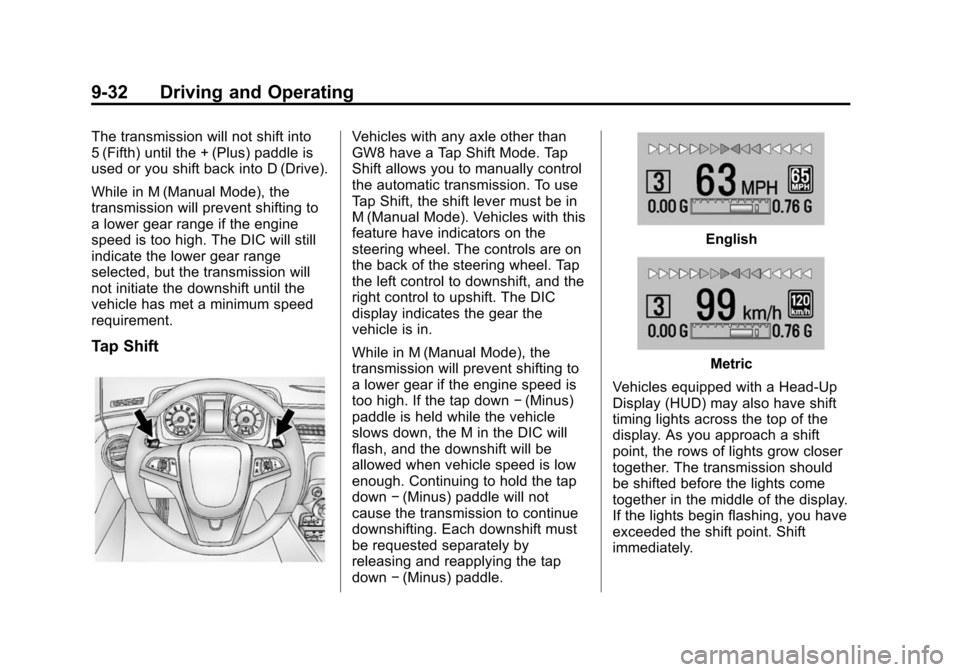
Black plate (32,1)Chevrolet Camaro Owner Manual (GMNA-Localizing-U.S./Canada/Mexico-
7695163) - 2015 - crc - 9/4/14
9-32 Driving and Operating
The transmission will not shift into
5 (Fifth) until the + (Plus) paddle is
used or you shift back into D (Drive).
While in M (Manual Mode), the
transmission will prevent shifting to
a lower gear range if the engine
speed is too high. The DIC will still
indicate the lower gear range
selected, but the transmission will
not initiate the downshift until the
vehicle has met a minimum speed
requirement.
Tap Shift
Vehicles with any axle other than
GW8 have a Tap Shift Mode. Tap
Shift allows you to manually control
the automatic transmission. To use
Tap Shift, the shift lever must be in
M (Manual Mode). Vehicles with this
feature have indicators on the
steering wheel. The controls are on
the back of the steering wheel. Tap
the left control to downshift, and the
right control to upshift. The DIC
display indicates the gear the
vehicle is in.
While in M (Manual Mode), the
transmission will prevent shifting to
a lower gear if the engine speed is
too high. If the tap down−(Minus)
paddle is held while the vehicle
slows down, the M in the DIC will
flash, and the downshift will be
allowed when vehicle speed is low
enough. Continuing to hold the tap
down −(Minus) paddle will not
cause the transmission to continue
downshifting. Each downshift must
be requested separately by
releasing and reapplying the tap
down −(Minus) paddle.
English
Metric
Vehicles equipped with a Head-Up
Display (HUD) may also have shift
timing lights across the top of the
display. As you approach a shift
point, the rows of lights grow closer
together. The transmission should
be shifted before the lights come
together in the middle of the display.
If the lights begin flashing, you have
exceeded the shift point. Shift
immediately.
Page 234 of 435

Black plate (33,1)Chevrolet Camaro Owner Manual (GMNA-Localizing-U.S./Canada/Mexico-
7695163) - 2015 - crc - 9/4/14
Driving and Operating 9-33
SeeDriver Information Center (DIC)
on page 5-24 andHead-Up Display
(HUD) on page 5-28.
When in Tap Shift Mode, you can
exit Tap Shift by holding the right
(upshift) control for two seconds.
The transmission will return to
automatic shifting.
You may choose to briefly enter Tap
Shift Mode while in D (Drive).
Tapping either the upshift or
downshift control will place the
transmission in Tap Shift Mode. Exit
Tap Shift Mode by holding the
upshift control for two seconds. The
system will return to automatic
shifting after 10 seconds of cruising
at a steady speed, or when the
vehicle comes to a stop. You may use this for sport driving or
when climbing or descending hills,
to stay in gear longer, or to
downshift for more power or engine
braking. The transmission will only
allow you to shift into gears
appropriate for the vehicle speed
and engine revolutions per minute
(rpm). The transmission will not
automatically shift to the next higher
gear if the engine rpm is too high.
If shifting is prevented for any
reason, the message SHIFT
DENIED will appear in the DIC,
indicating that the transmission has
not shifted gears. While in the Tap
Shift Mode, the transmission will not
automatically downshift on hard
acceleration.
When coasting to a stop in Tap Shift
Mode, the V6 transmission will
automatically downshift to 1 (First)
gear, and the V8 transmission will
automatically downshift to
2 (Second) gear. A 1 (First) gear
start can be selected using the Tap
Shift controls on V8 models. When
accelerating from a stop, the
transmissions will hold these gears
until higher gears are manually
selected using the Tap Shift
controls.
When accelerating the vehicle from
a stop in snowy and icy conditions,
you may want to shift into
2 (Second) gear. A higher gear ratio
allows you to gain more traction on
slippery surfaces. ZL1 vehicles may
also be shifted into 3 (Third) gear.
Page 236 of 435
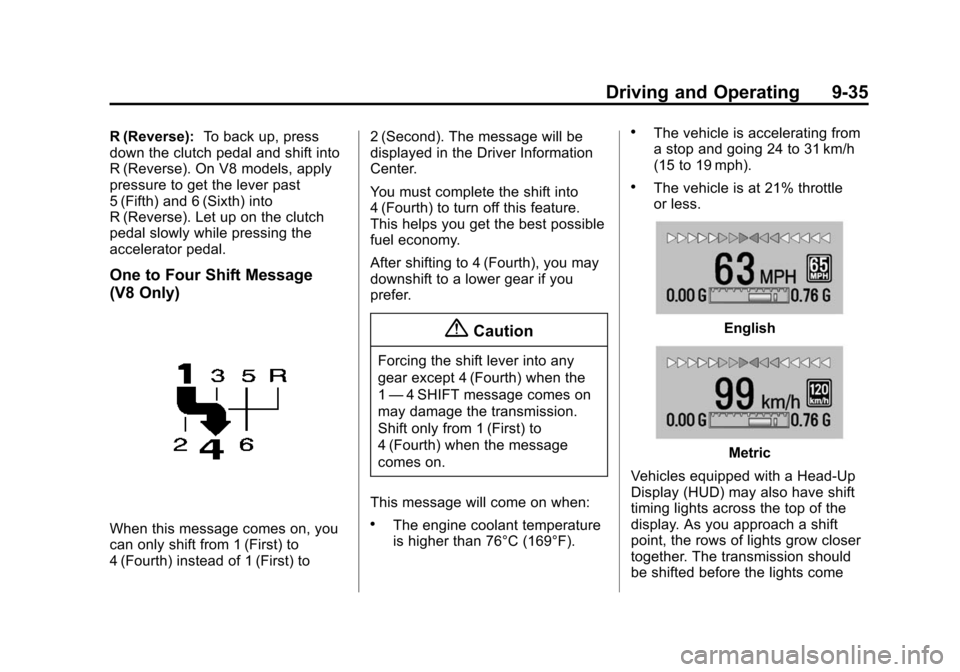
Black plate (35,1)Chevrolet Camaro Owner Manual (GMNA-Localizing-U.S./Canada/Mexico-
7695163) - 2015 - crc - 9/4/14
Driving and Operating 9-35
R (Reverse):To back up, press
down the clutch pedal and shift into
R (Reverse). On V8 models, apply
pressure to get the lever past
5 (Fifth) and 6 (Sixth) into
R (Reverse). Let up on the clutch
pedal slowly while pressing the
accelerator pedal.
One to Four Shift Message
(V8 Only)
When this message comes on, you
can only shift from 1 (First) to
4 (Fourth) instead of 1 (First) to 2 (Second). The message will be
displayed in the Driver Information
Center.
You must complete the shift into
4 (Fourth) to turn off this feature.
This helps you get the best possible
fuel economy.
After shifting to 4 (Fourth), you may
downshift to a lower gear if you
prefer.
{Caution
Forcing the shift lever into any
gear except 4 (Fourth) when the
1
— 4 SHIFT message comes on
may damage the transmission.
Shift only from 1 (First) to
4 (Fourth) when the message
comes on.
This message will come on when:
.The engine coolant temperature
is higher than 76°C (169°F).
.The vehicle is accelerating from
a stop and going 24 to 31 km/h
(15 to 19 mph).
.The vehicle is at 21% throttle
or less.
English
Metric
Vehicles equipped with a Head-Up
Display (HUD) may also have shift
timing lights across the top of the
display. As you approach a shift
point, the rows of lights grow closer
together. The transmission should
be shifted before the lights come
Page 237 of 435
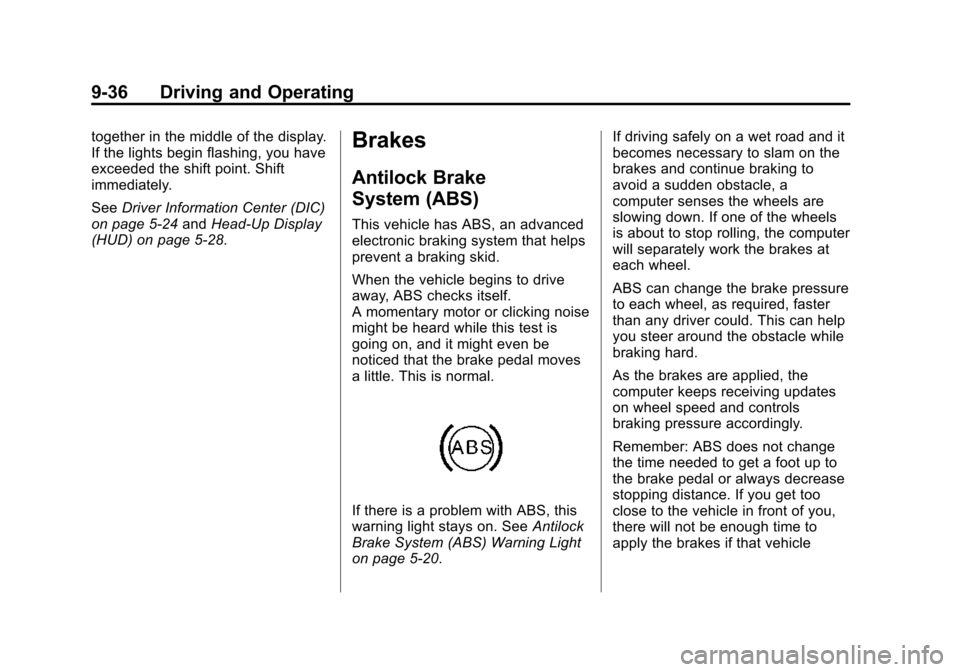
Black plate (36,1)Chevrolet Camaro Owner Manual (GMNA-Localizing-U.S./Canada/Mexico-
7695163) - 2015 - crc - 9/4/14
9-36 Driving and Operating
together in the middle of the display.
If the lights begin flashing, you have
exceeded the shift point. Shift
immediately.
SeeDriver Information Center (DIC)
on page 5-24 andHead-Up Display
(HUD) on page 5-28.Brakes
Antilock Brake
System (ABS)
This vehicle has ABS, an advanced
electronic braking system that helps
prevent a braking skid.
When the vehicle begins to drive
away, ABS checks itself.
A momentary motor or clicking noise
might be heard while this test is
going on, and it might even be
noticed that the brake pedal moves
a little. This is normal.
If there is a problem with ABS, this
warning light stays on. See Antilock
Brake System (ABS) Warning Light
on page 5-20. If driving safely on a wet road and it
becomes necessary to slam on the
brakes and continue braking to
avoid a sudden obstacle, a
computer senses the wheels are
slowing down. If one of the wheels
is about to stop rolling, the computer
will separately work the brakes at
each wheel.
ABS can change the brake pressure
to each wheel, as required, faster
than any driver could. This can help
you steer around the obstacle while
braking hard.
As the brakes are applied, the
computer keeps receiving updates
on wheel speed and controls
braking pressure accordingly.
Remember: ABS does not change
the time needed to get a foot up to
the brake pedal or always decrease
stopping distance. If you get too
close to the vehicle in front of you,
there will not be enough time to
apply the brakes if that vehicle
Page 240 of 435

Black plate (39,1)Chevrolet Camaro Owner Manual (GMNA-Localizing-U.S./Canada/Mexico-
7695163) - 2015 - crc - 9/4/14
Driving and Operating 9-39
vehicle wheel brakes to assist the
driver in keeping the vehicle on the
intended path.
If cruise control is being used and
traction control or StabiliTrak begins
to limit wheel spin, cruise control will
disengage. Cruise control may be
turned back on when road
conditions allow.
Both systems come on
automatically when the vehicle is
started and begins to move. The
systems may be heard or felt while
they are operating or while
performing diagnostic checks. This
is normal and does not mean there
is a problem with the vehicle.
It is recommended to leave both
systems on for normal driving
conditions, but it may be necessary
to turn TCS off if the vehicle gets
stuck in sand, mud, ice, or snow.
SeeIf the Vehicle Is Stuck on
page 9-13 and“Turning the
Systems Off and On” later in this
section.
The indicator light for both systems
is in the instrument cluster. This
light will:
.Flash when TCS is limiting
wheel spin.
.Flash when StabiliTrak is
activated.
.Turn on and stay on when either
system is not working.
If either system fails to turn on or to
activate, a message displays in the
Driver Information Center (DIC),
and
dcomes on and stays on to
indicate that the system is inactive
and is not assisting the driver in
maintaining control. The vehicle is
safe to drive, but driving should be
adjusted accordingly. If
dcomes on and stays on:
1. Stop the vehicle.
2. Turn the engine off and wait 15 seconds.
3. Start the engine.
Drive the vehicle. If
dcomes on
and stays on, the vehicle may need
more time to diagnose the problem.
If the condition persists, see your
dealer.
Turning the Systems Off
and On
The button for TCS and StabiliTrak
is on the center console in front of
the shift lever.
Page 241 of 435
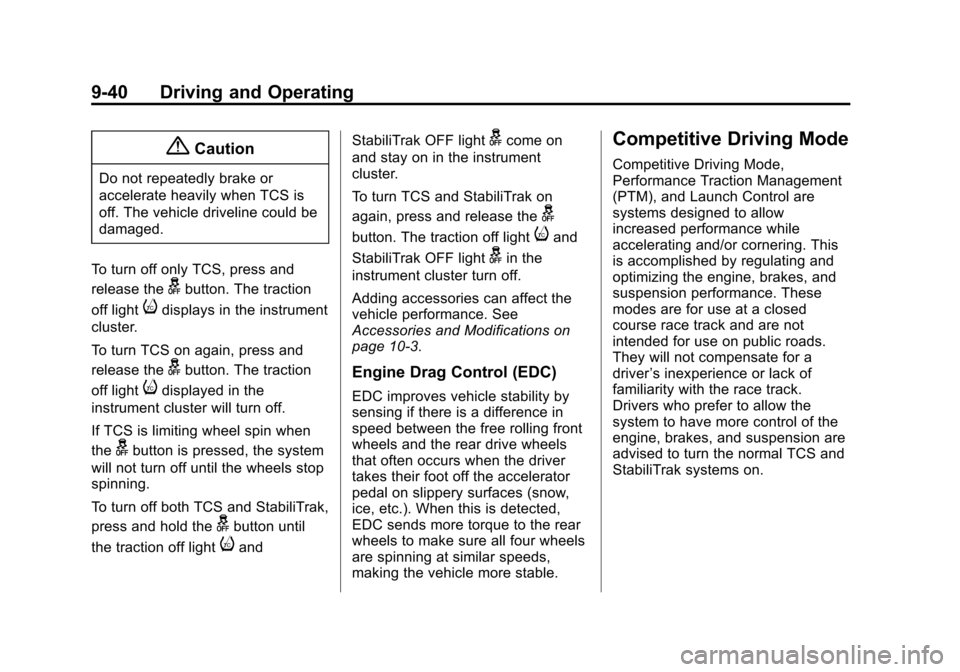
Black plate (40,1)Chevrolet Camaro Owner Manual (GMNA-Localizing-U.S./Canada/Mexico-
7695163) - 2015 - crc - 9/4/14
9-40 Driving and Operating
{Caution
Do not repeatedly brake or
accelerate heavily when TCS is
off. The vehicle driveline could be
damaged.
To turn off only TCS, press and
release the
gbutton. The traction
off light
idisplays in the instrument
cluster.
To turn TCS on again, press and
release the
gbutton. The traction
off light
idisplayed in the
instrument cluster will turn off.
If TCS is limiting wheel spin when
the
gbutton is pressed, the system
will not turn off until the wheels stop
spinning.
To turn off both TCS and StabiliTrak,
press and hold the
gbutton until
the traction off light
iand StabiliTrak OFF light
gcome on
and stay on in the instrument
cluster.
To turn TCS and StabiliTrak on
again, press and release the
g
button. The traction off lightiand
StabiliTrak OFF light
gin the
instrument cluster turn off.
Adding accessories can affect the
vehicle performance. See
Accessories and Modifications on
page 10-3.
Engine Drag Control (EDC)
EDC improves vehicle stability by
sensing if there is a difference in
speed between the free rolling front
wheels and the rear drive wheels
that often occurs when the driver
takes their foot off the accelerator
pedal on slippery surfaces (snow,
ice, etc.). When this is detected,
EDC sends more torque to the rear
wheels to make sure all four wheels
are spinning at similar speeds,
making the vehicle more stable.
Competitive Driving Mode
Competitive Driving Mode,
Performance Traction Management
(PTM), and Launch Control are
systems designed to allow
increased performance while
accelerating and/or cornering. This
is accomplished by regulating and
optimizing the engine, brakes, and
suspension performance. These
modes are for use at a closed
course race track and are not
intended for use on public roads.
They will not compensate for a
driver ’s inexperience or lack of
familiarity with the race track.
Drivers who prefer to allow the
system to have more control of the
engine, brakes, and suspension are
advised to turn the normal TCS and
StabiliTrak systems on.
Page 242 of 435
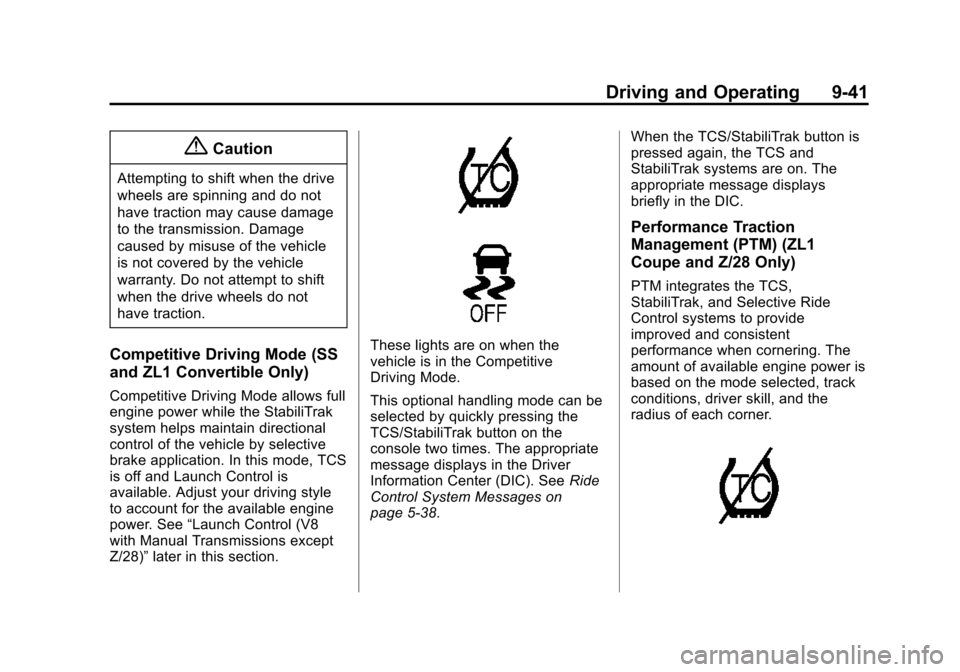
Black plate (41,1)Chevrolet Camaro Owner Manual (GMNA-Localizing-U.S./Canada/Mexico-
7695163) - 2015 - crc - 9/4/14
Driving and Operating 9-41
{Caution
Attempting to shift when the drive
wheels are spinning and do not
have traction may cause damage
to the transmission. Damage
caused by misuse of the vehicle
is not covered by the vehicle
warranty. Do not attempt to shift
when the drive wheels do not
have traction.
Competitive Driving Mode (SS
and ZL1 Convertible Only)
Competitive Driving Mode allows full
engine power while the StabiliTrak
system helps maintain directional
control of the vehicle by selective
brake application. In this mode, TCS
is off and Launch Control is
available. Adjust your driving style
to account for the available engine
power. See“Launch Control (V8
with Manual Transmissions except
Z/28)” later in this section.
These lights are on when the
vehicle is in the Competitive
Driving Mode.
This optional handling mode can be
selected by quickly pressing the
TCS/StabiliTrak button on the
console two times. The appropriate
message displays in the Driver
Information Center (DIC). See Ride
Control System Messages on
page 5-38. When the TCS/StabiliTrak button is
pressed again, the TCS and
StabiliTrak systems are on. The
appropriate message displays
briefly in the DIC.
Performance Traction
Management (PTM) (ZL1
Coupe and Z/28 Only)
PTM integrates the TCS,
StabiliTrak, and Selective Ride
Control systems to provide
improved and consistent
performance when cornering. The
amount of available engine power is
based on the mode selected, track
conditions, driver skill, and the
radius of each corner.
Page 243 of 435
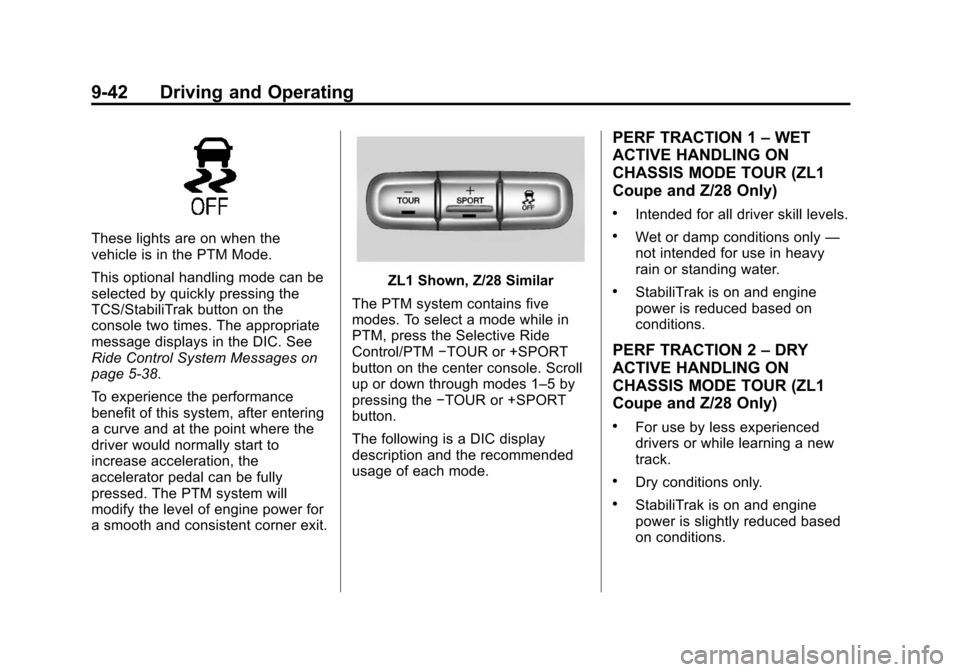
Black plate (42,1)Chevrolet Camaro Owner Manual (GMNA-Localizing-U.S./Canada/Mexico-
7695163) - 2015 - crc - 9/4/14
9-42 Driving and Operating
These lights are on when the
vehicle is in the PTM Mode.
This optional handling mode can be
selected by quickly pressing the
TCS/StabiliTrak button on the
console two times. The appropriate
message displays in the DIC. See
Ride Control System Messages on
page 5-38.
To experience the performance
benefit of this system, after entering
a curve and at the point where the
driver would normally start to
increase acceleration, the
accelerator pedal can be fully
pressed. The PTM system will
modify the level of engine power for
a smooth and consistent corner exit.
ZL1 Shown, Z/28 Similar
The PTM system contains five
modes. To select a mode while in
PTM, press the Selective Ride
Control/PTM −TOUR or +SPORT
button on the center console. Scroll
up or down through modes 1–5 by
pressing the −TOUR or +SPORT
button.
The following is a DIC display
description and the recommended
usage of each mode.
PERF TRACTION 1 –WET
ACTIVE HANDLING ON
CHASSIS MODE TOUR (ZL1
Coupe and Z/28 Only)
.Intended for all driver skill levels.
.Wet or damp conditions only —
not intended for use in heavy
rain or standing water.
.StabiliTrak is on and engine
power is reduced based on
conditions.
PERF TRACTION 2 –DRY
ACTIVE HANDLING ON
CHASSIS MODE TOUR (ZL1
Coupe and Z/28 Only)
.For use by less experienced
drivers or while learning a new
track.
.Dry conditions only.
.StabiliTrak is on and engine
power is slightly reduced based
on conditions.